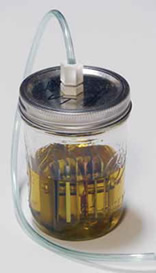
156
If you really must know how we compared the fuel additives, here are the particulars.
• Fuel sample size: 250 milliliters.
• Sample composition: E-10 gasoline with 0.03-percent seawater added. This is not enough to cause phase separation, since E-10 can hold about 0.5 percent water in solution.
• Gasoline additive dose: All samples were treated at manufacturer recommended levels for seasonal storage. If the product was not recommended specifically for seasonal storage, the routine usage dose was doubled.
• Metal sample preparation: all samples were polished and weighed to within 0.1 mg.
• Air exposure: Each jar was fitted with a vent made from 8 inches of 3/16-inch clear vinyl tubing. EPA studies suggest that this will give an amount of breathing comparable to a fuel tank with a 5/8-inch vent that is 3 feet long.
• Temperature and humidity exposure: All samples were kept outside from April 20, 2012 to May 20, 2012 in the Chesapeake Bay area.
• Post-exposure coupon inspection: Each metal sample was visually observed and re-weighed. The change in weight and any evidence of tarnish were noted.
Although change in weight ranged from a 2-milligram gain to 20-milligram loss, we did not report these values, as in most cases, they were not statistically meaningful, the value depending very heavily on the size of the few largest pits. This methodology is common in coolant testing, where weight loss on pitted samples is extremely variable. The visual results were more consistent.
The test used three controls: one sample contained no seawater, no aftermarket gasoline additive, and was sealed with a tight lid to eliminate evaporation, oxygen absorption, and water absorption; one sample contained no seawater, no aftermarket gas additive, and was vented in the same manner as the test bottles; one sample contained 0.03 percent seawater and was vented in the same manner as the test bottles, but contained no aftermarket gasoline additive.







































